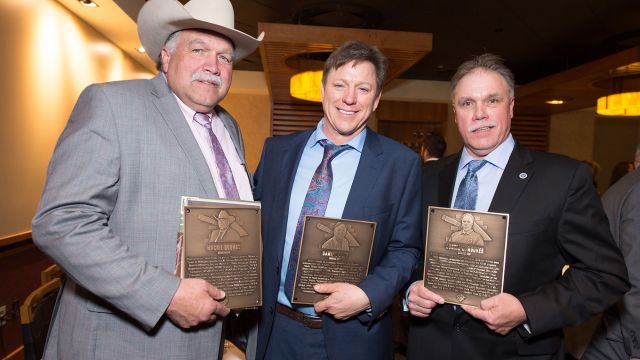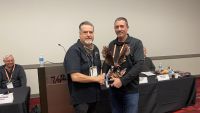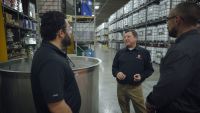Five Inductees Enter Masonry Hall of Fame
Bounds, Breithaupt, Catani, Hoover, and Lang Inducted to Masonry Hall of Fame
On Thursday, January 25, 2018, the Mason Contractors Association of America (MCAA) inducted five individuals into the 2018 Masonry Hall of Fame class during the MCAA Convention at the World of Concrete/World of Masonry in Las Vegas.
The 2018 Masonry Hall of Fame inductees included Mackie Bounds; Justin Breithaupt, Sr.; Mario Catani, Curtis C. Hoover, and Damian Lang.
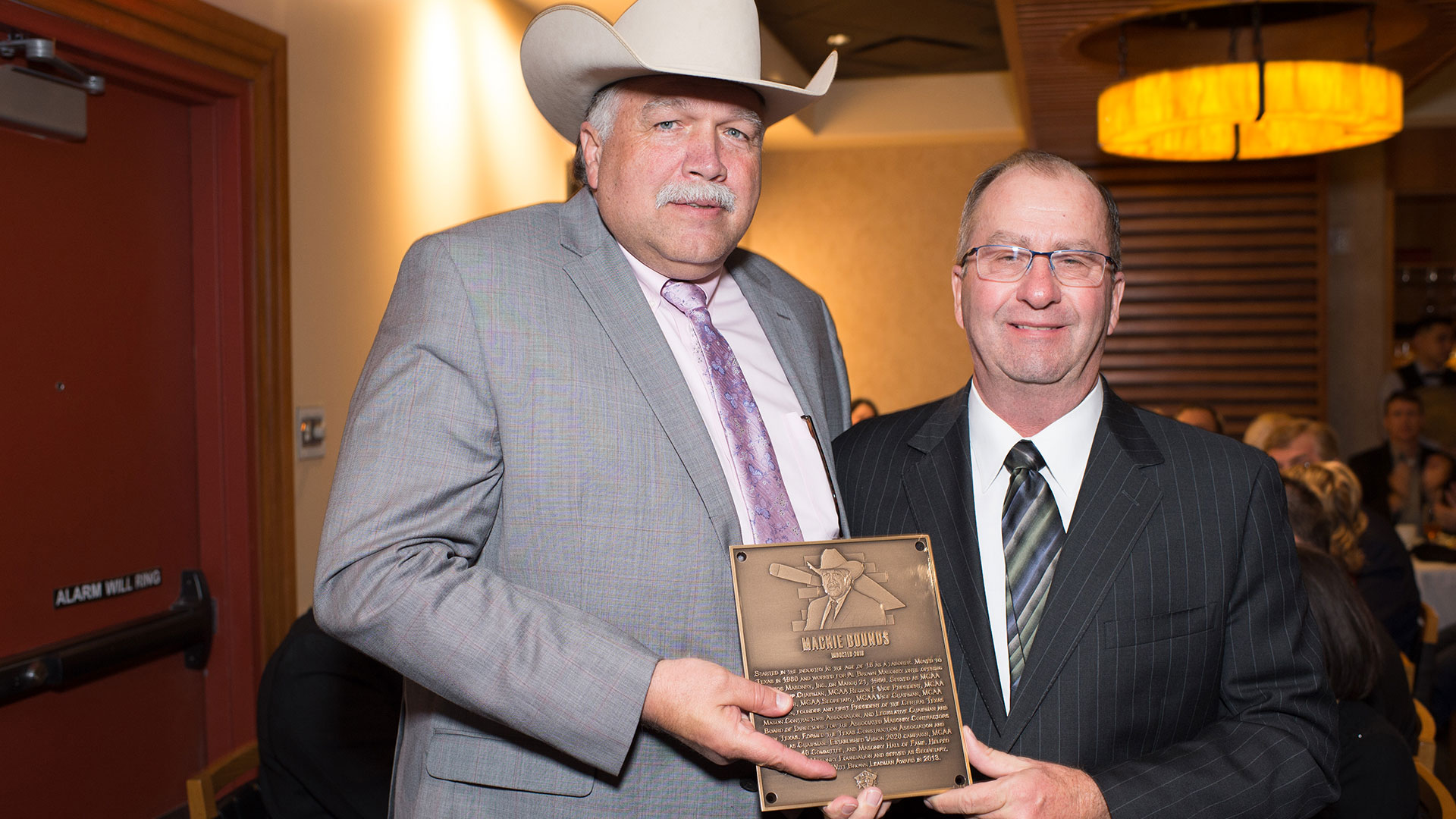
Mackie Bounds
Mr. Bounds joined the MCAA in March of 1989. The 2018 convention will make 30 straight conventions for him.He started in the industry at the age of 16 as a laborer in Bloomington, IN. It was his summertime job, but a seed was planted. Upon graduation, he worked for a short period of time in his family’s retail carpet business, but the masonry world was in his blood.
In 1980, Mackie and his wife moved to Texas and he went to work immediately in the construction industry. He soon went to work for Al Brown Masonry and continued there until opening his own business March 21, 1989, which was also his birthday. He always said he was young and dumb, but we all know he had a vision! His first step was to join MCAA. He believed in supporting the industry and to be a part of it. His first convention was in 1988 when at Al Brown Masonry and he saw then the importance of his membership.
Mackie and wife, Norma Jean, are blessed with two children, son Kent and daughter Crystal. They saw the determination and drive and stood with him and behind him as he pursued his dream. Kent will tell you that his $.50 weekly allowance even came to an end. Mackie became the membership chairman of MCAA and always thought every mason contractor in the country should be a member. His goal was 1200 members, but before he could do that in 1997 he became a regional Vice President of MCAA.
Back at home, he put mason contractors together with the help of suppliers and in 1995 started the Central Texas Mason Contractors Association and became the first President of the association. He also served many years on the board of directors of the Associated Masonry Contractors of Texas (later named Texas Masonry Council). He was also legislative chairman of the association. As regional Vice President of MCAA, he made the motion to change the Lead Man Award to the Dee Brown Lead Man Award. Mr. Brown always addressed Mackie as “the kid” and it was his privilege to show the world his respect for Dee Brown. It wasn’t long before he was nominated to be MCAA Treasurer and started his climb to the President of MCAA.
Back at home, he was working with other trades and was helping put together a legislative voice for all subcontractors in Texas. It was soon formed as the Texas Construction Association. He spent hours at the Capital in Austin and was instrumental in the passage of the Prompt Pay Act in Texas and also getting laws passed that protected subs on “Contingency Pay clauses and Indemnity clauses”. Now the Texas Construction Association has a multimillion dollar budget and has become the strongest voice at the Capital when it comes to Construction Law. He also served five years as chairman of the Texas Subcontractors Association. While chairman, the association was given the Hammer Award as the fastest growing chapter of the American Subcontractors Association.
At MCAA, many changes took place as he was coming up the ladder as Secretary and Vice President. Mackie and Norma Jean still treasure all the many friendships that have been established in the industry at home, in the state and nationally. When Mackie became President, the national economy was at a low and MCAA was very low on funds. He rolled up his sleeves and started a journey. He worked feverishly to bring a fragmented industry together. He met with all industry associations and had open dialog. The first Midyear Meeting of his term was held with NCMA mid-year. He formed an alliance by traveling over 60,000 miles in his two years bringing people together in a tough time. He opened discussions with NCCER to help address manpower issues. He traveled to Washington, D.C., meeting with Congressmen and Senators addressing the use of masonry in government buildings and went to the Pentagon with the help of his congressmen to promote sustainable construction for our soldiers. He kicked off Vision 2020 to have more masonry used nationwide by the year 2020. He established active committees that worked on behalf of the industry and specifically the MCAA. He knew the future was important and started the South of 40 Committee and had four committee chairs that were south of 40. He also recognized pride was needed back in our industry. He, with the help of others, established the Masonry Hall of Fame. He was so proud to induct Dee Brown in the very first class! He felt, once again “the kid” had come through.
Mackie has always loved his community. He is a Paul Harris Rotarian and was very active in many associations. He served as President of Axtell FFA Ag Booster Club, was awarded a Lone Star FFA Degree by the Texas FFA officers, served as Chairman of the McLennan County Jr. Livestock Show & Sale, served as Chairman of the Board of the Heart of Texas Fair Complex, which impacted the local economy $60 million per year and the list goes on. He has helped raise millions of dollars for youth scholarships throughout Texas. He also loves his cattle and ranch and served many years on the Beefmaster Board of Directors and as Chairman of the Board for two years. He finds rest looking at cattle and enjoying a part of God’s creation.
As he left MCAA Chairman role, with the help of Tom Daniels, they brought a vision to reality - The Masonry Foundation. He simply wanted masonry to be there for years and years, but not just there also at the top of the construction industry.
The things that mean the most to him have nothing to do with work - his wife of 39+ years, his two children and their spouses, and his three grandchildren. His foundation is in his God as he reads his bible every day and prays many times each day. The Church has always come first even when it meant less time for himself. He now looks forward in helping others to be happy and enjoy life.
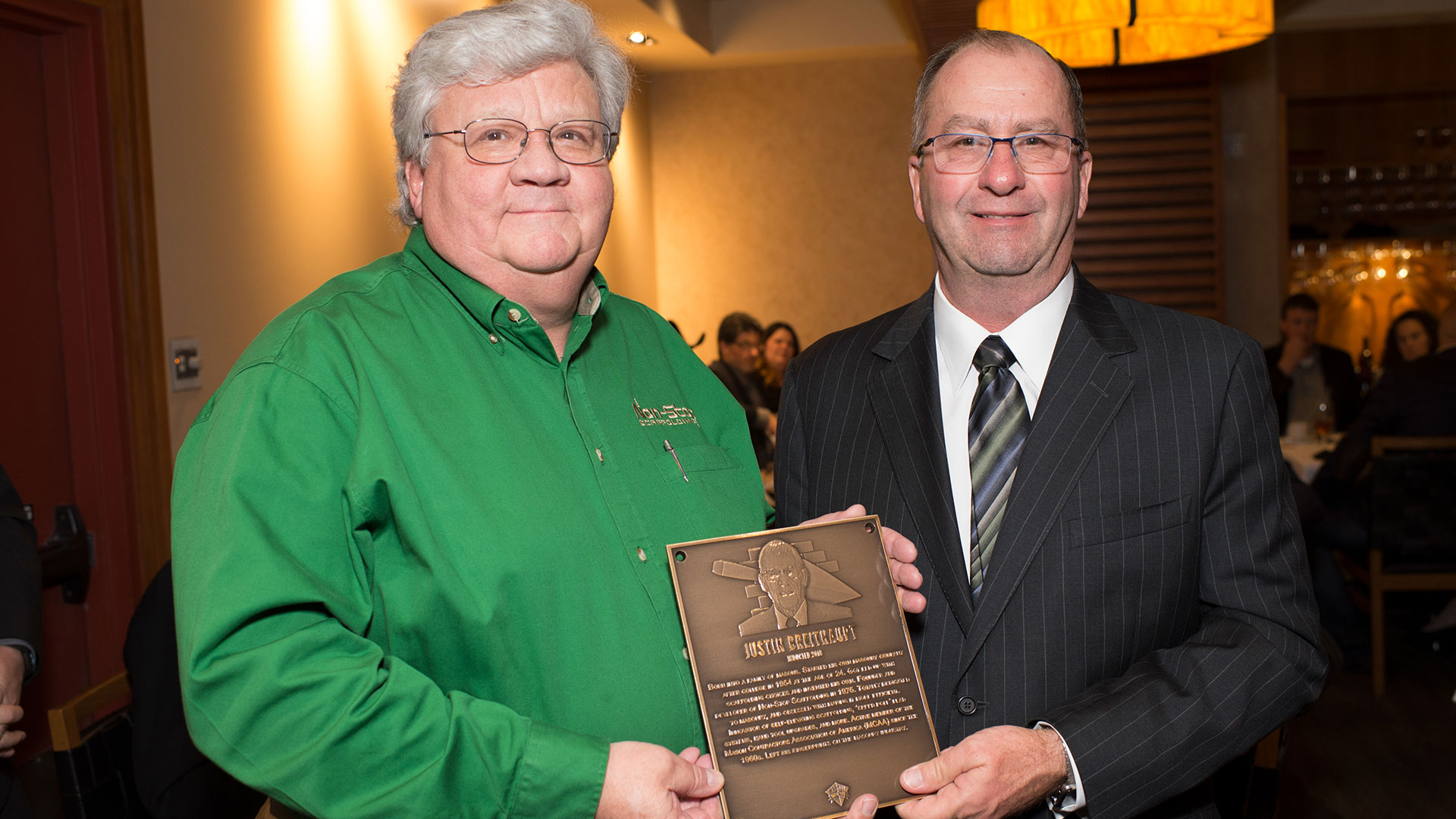
Justin Breithaupt, Sr.
Justin Breithaupt, Sr. was born into a family of masons. He started his own masonry company after college in 1954 at the age of 24. Justin got fed up with scaffolding choices and decided to invent his own, founding and developing Non-Stop Scaffolding in 1975.Justin was totally dedicated to masonry, and was obsessed with making it more efficient. He was the innovator of self-elevating scaffolding, ‘speed pole’ lead systems, hand tool upgrades, and more. An active member of the Mason Contractors Association of America (MCAA) since the 1960s, Justin Breithaupt, Sr. had his finger prints on the masonry industry.
Mario Catani
Mario Catani’s career can be described as masonry, masonry and masonry; that’s masonry design, masonry codes and masonry products. For example, because of him, thousands of engineers, architects and contractors called joint reinforcement “Dur-O-Wal” for decades. That illustrates his influence on the masonry industry, but I submit that there was much more that many industry people don’t know. In the 1960s, there were no national masonry standards. NCMA published its first Concrete Masonry Design Manual in 1969. The manual was essentially a guide to designing unreinforced masonry. Mario’s career started out as an engineer and in 1968, he was one of the first two consulting engineers in New Jersey to design a multi-story apartment building using the engineered concrete masonry design manual even before it was published. He was a masonry guy from the beginning! That design put him at the forefront of masonry standards and affected his entire career. His design experience took him to the Portland Cement Association (PCA) in 1969 to promote load bearing masonry and to advise engineers on the use of the NCMA Design Manual. Engineers needed guidance; few had been exposed to masonry design in college and there were no national standards. The NCMA Design Manual was a great start, but it was not code. Having Mario, a knowledgeable design engineer, as a technical advisor was crucial to developing numerous projects.Then in 1971, Mario joined Akron Brick and Block Company in Ohio as its Vice President. Here his advocacy for masonry design increased and his talents turned to actually developing masonry standards. At that time, the American Concrete Institute was the only organization contemplating developing a consensus standard for engineered concrete masonry and Mario was there to join ACI 531. In 1974, he returned to PCA to lead the cement industry in building promotion with a strong emphasis on load bearing masonry design and construction; and he continued his code development with ACI. That code effort led to their first ACI document published titled ACI 531-79, Building Code Requirements for Concrete Masonry Structures. This was a major achievement, but it still was only for concrete masonry. A major career move for Mario occurred in 1981. He joined the Dur-O-Wal company and became President and CEO. During his tenure, he produced six masonry patents for anchors and joint reinforcement, pushed the industry forward, and made Dur-O-Wal the gold standard for masonry products. Dur-O-Wal was known for quality products and innovation. We didn’t know Catani, but we knew Dur-O-Wal.
Mario understood the importance of strong codes and standards to the industry and accepted the first-ever chair position for the Joint American Concrete Institute, American Society of Civil Engineers Committee 530. This was the origination of what became the Masonry Standards Joint Committee (MSJC) which was created with the addition of The Masonry Society. Under his steady leadership and common-sense approach, the joint committee produced the first consensus-based, engineered masonry design standard ACI 530-88/ASCE 5-88, Building Code Requirements for Masonry Structures. The first design standard was ground-breaking because it consolidated the masonry design for concrete masonry and clay masonry in one document using engineered masonry principles, empirical design and more.
This was a pivotal time in the development of masonry codes in the US because earthquake standards were forcing the industry to move to reinforced masonry. Therefore for the first time, the standard included engineering provisions for both unreinforced and reinforced masonry in one standard along with seismic provisions. It became accepted as the masonry standard in building codes and evolved into the standard we know today as TMS 402, Building Code Requirements for Masonry Structures and Mario was our leader. Simultaneously, Mario was tasked as Chair to develop ACI 530.1-88/ASCE 6-88, Specifications for Masonry Structures. I remember many times when he would question a proposed change with statements such as “is this practical, can it be built, should we do this?” Mario was always thinking of the contractor and constructability and challenged the committee to keep it real. This was consistent with his approach to running Dur-O-Wal, where he innovated numerous products to meet the code requirements and make construction practical. The first Specifications was the first to bring together grouting, hot weather and cold weather practices, and more into one document. The specification document has lived on and is now TMS 602, Specifications for Masonry Structures. In addition to being MSJC committee chair, he used the resources of Dur-O-Wal to work with the committee to present countless seminars throughout the US to train engineers on the application of the new standards. It wasn’t enough to create standards, they had to be explained to designers and contractors. He also published numerous articles throughout his career. Mario’s leadership was so valued by the masonry industry that he subsequently was asked by the Mason Contractors of America (MCAA), National Concrete Masonry Association (NCMA), BIA and OSHA to chair the development of the industry’s standard for bracing masonry walls. This was a crucial issue for the masonry industry because OSHA threatened to create its own standard without masonry input if the masonry industry could not come together on a practical approach to masonry bracing that made life safety the key ingredient. In the end, OSHA approved the committee’s work. That document has been updated a few times and is published by MCAA. So today, every set of project specifications that references the Standard Practice for Bracing Masonry Walls Under Construction is thanks to Mario’s initial leadership.
So for all those that worked with Mario over the years, we experienced his common-sense approach to leadership, masonry code development, education of designers, improved materials and methods for mason contractors, and product development. While he retired to Tennessee in 1999, he left a legacy of masonry successes.
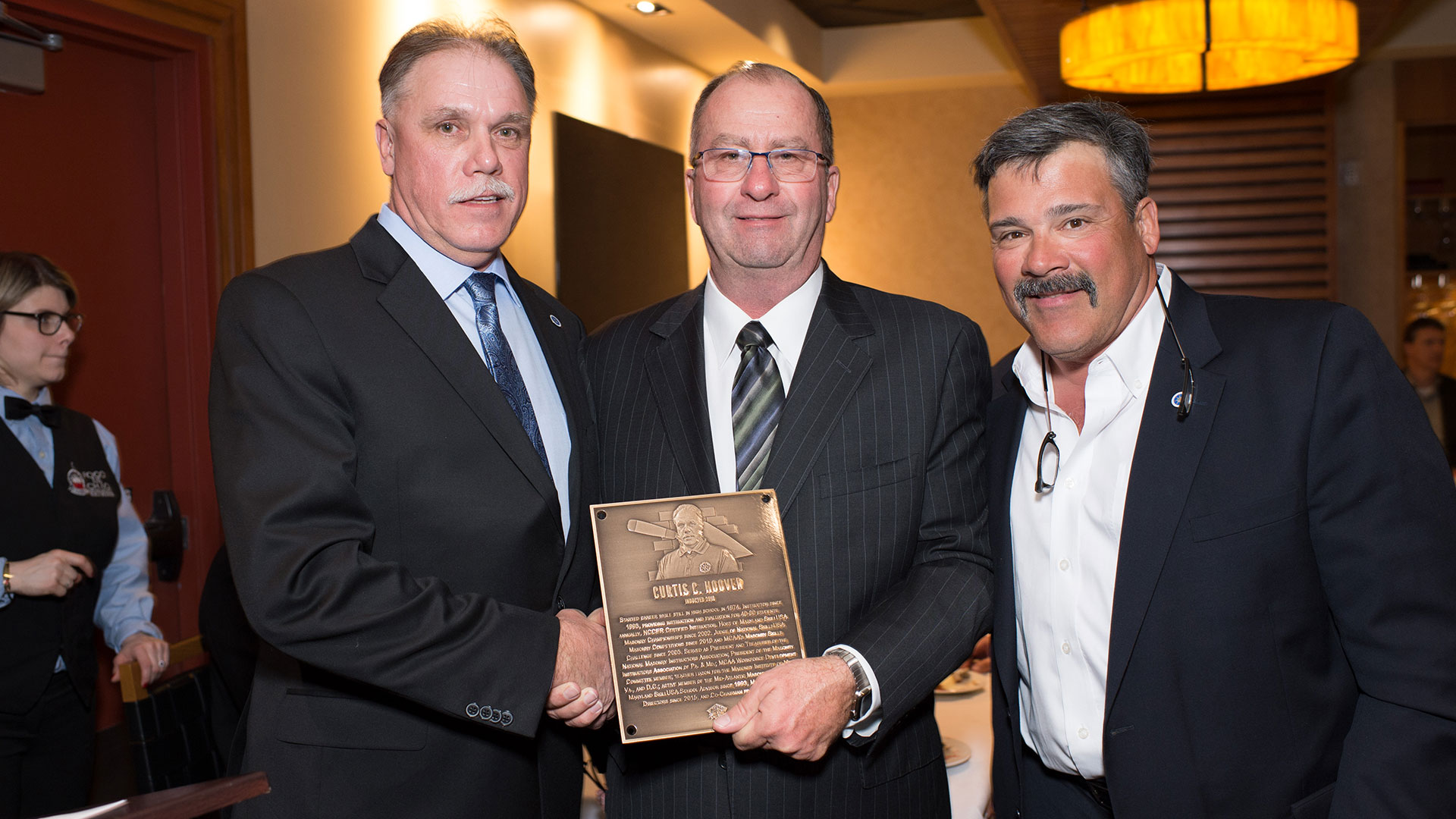
Curtis C. Hoover
Curtis C. Hoover started his career back in 1974, while still in high school. A new vo-tech center was opening called North Arundel Vo-Tech. This was just a technical school, which would be near the seven high schools in the north end of Anne Arundel County. He did not choose the masonry program. Instead, he signed up for the home improvement program. The related class for this program was masonry, a fact he did not know until second semester. After taking masonry that semester, he knew what he wanted to pursue for his career. Curtis fell in love with the class as it seemed to be natural for him.Curtis’ class was introduced to VICA (Vocational Industrial Clubs of America) known today as SkillsUSA. His first full year, he competed in the state VICA Masonry Competition and placed fourth. In his senior year, he placed second and won a Silver Medal. This was the first medal ever won for his school. His dad had it placed in a frame, which currently he displays for all his students in hopes of encouraging them to do their best. Curtis wants them to know that they can accomplish anything if they work hard and put their minds to it.
Curtis started doing little masonry jobs while still in school, and was amazed by what kind of money one could make. He built his first fireplace at the age of 16, and was paid $400.00 which helped him purchase a car. He officially started his career going out on work study his senior year for R.L. Walker and Sons, which was a residential masonry contractor. Most of the work was bricking up the front of houses, foundations and fireplaces. He worked for R.L. Walker for one and a half years.
Curtis always remained in contact with his masonry instructor. One day, they were talking when Curtis mentioned he wanted to get with a company that had benefits. His brother was a foreman for Henry J. Knott, Inc. which was one of the largest union masonry contractors in the Baltimore area. They hired Curtis in 1978. He started working as a bricklayer, then in 1982 he began as a foreman at the age of 25. Soon after the company began to grow and they were looking for an Assistant Superintendent, a job which included training new foremen from within the company. The tasks included blueprint reading classes, safety meetings, documentation of the jobs, and many other items involved in running a project. It also involved running a yard, which included all of the equipment needs, clean-up of jobs, etc. Curtis loved that job, but the economy in the first part of the 90’s was on a downward trend, which hurt the company. He ended up going back in the field as a foreman.
In the summer of 1993, he was building the Lowes store in Salisbury, Md., when he received a phone call from his masonry teacher, telling him that the masonry instructor position was open at his old school. He applied, did two interviews, one of which was with his former principal. He was selected out of eight other candidates. The toughest thing about taking the position was telling Henry J. Knott that he was leaving his company. He said he understood and wished Curtis the best of luck and if it didn’t work out, Curtis was always welcome to come back. They are still very good friends today, and Curtis tries to send him some of his students whenever he can.
After taking the masonry instructors position, he attended his first Masonry Showcase in Charlotte in 1995. It was very impressive and he knew he had to get involved. Curtis received a phone call from a young lady about judging the Masonry Skills Challenge in Tampa, Florida. It was a great honor to be asked to judge. This is when he met some great gentlemen, who were also masonry instructors. Mr. Milton Young and Mr. Eugene Johnson were talking about the National Masonry Instructors Association (NMIA) and suggested Curtis should join. He did. This organization is more like family than just peers. Curtis has had the privilege serving as President of the National Masonry Instructors Association for 5 years, and is now Treasurer. He will always be the NMIA spokesperson.
One will never know where or what event Curtis will attend. He has spent his entire life both as a teen and as an adult, in this great field of masonry and will continue as long as the good Lord allows him to. His words to other instructors have always been, “GET INVOLVED, in whatever organization that can help you and your students be successful.” There are no words or money that can put a price on watching a student succeed in industry, and Curtis is lucky enough to have many.
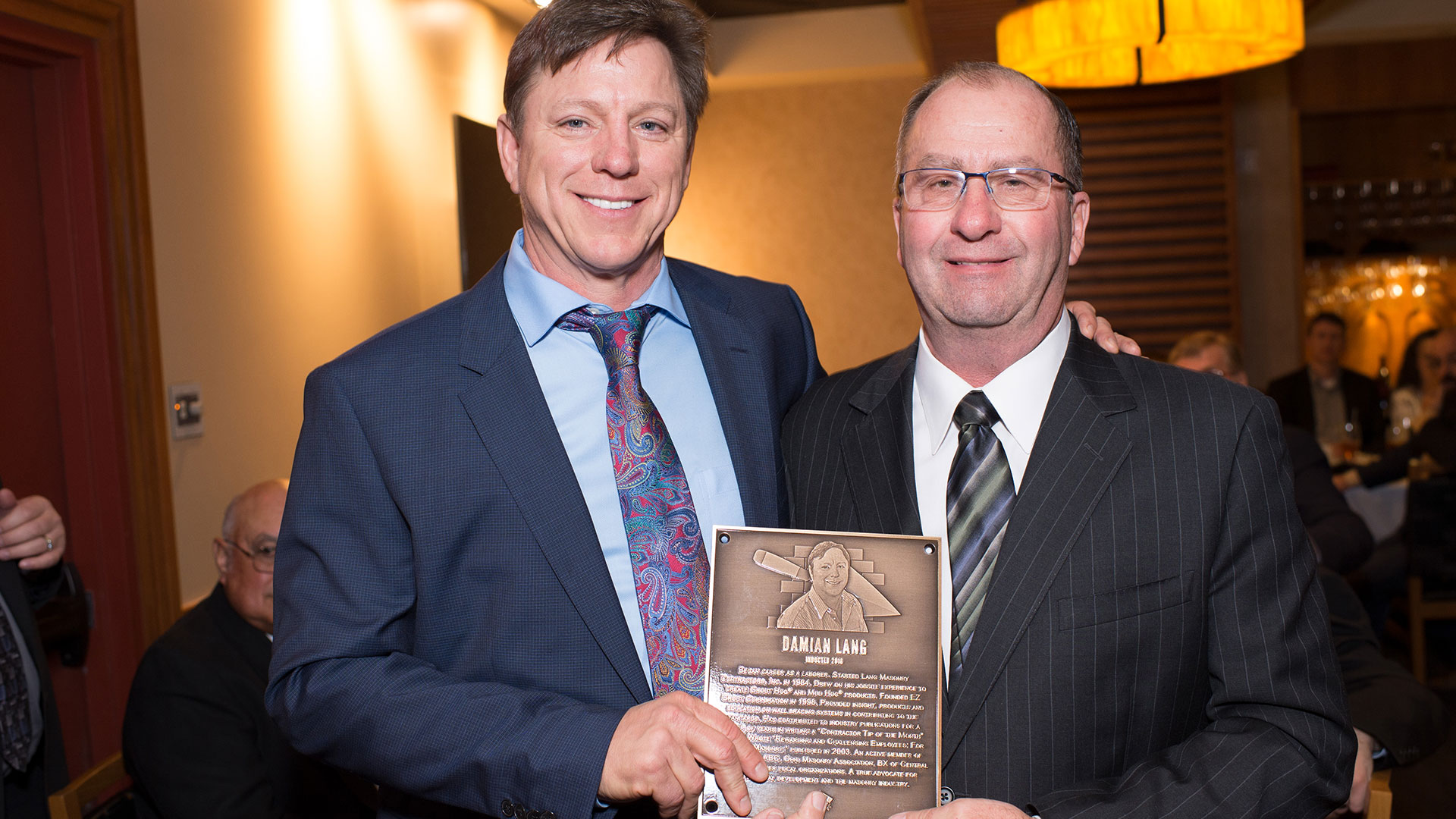
Damian Lang
Damian grew up in the small rural community of Waterford, OH. He resides there today, close to his childhood home. Not only is he a great contributor to the masonry industry, he has an undying dedication to his workforce, family, and community. His impact on the local economic development is immeasurable. He began as a laborer, mixing and carrying mortar to the bricklayers. In 1984, after borrowing $800 to buy his first pickup truck, he started his own masonry company focusing on residential basements and brick houses. In the early days, he used 55 gallon drums for scaffolding and pine boards for scaffolding plank. After years of experience in owning and operating a successful business with the masonry industry, Damian drew on this jobsite experience to create Grout Hog® and Mud Hog® products which are now being used by masons throughout the United States and around the world. EZ Grout Corporation was founded in 1998 as a sister company to LMC to provide ergonomic and laborsaving equipment to the masonry industry. These products have literally transformed the Masonry industry in how mortar is mixed and grout is delivered into block walls. Damian has also provided insight, products and education on wall bracing systems in contributing to the standards and developing the Hog Leg® products.From the inception of his first company, Lang Masonry & Restoration Contractors, safety, quality and customer service has been the founding strength of his success. Damian paves the way for the masonry industry by constantly staying in tune with current issues in the industry and being at the front of solving problems not only for his company leaders and workforce but all masonry companies who need advice on day to day operations. He has contributed to Masonry Magazine for a number of years in writing a Contractor Tip of the Month article that reaches thousands of readers. Today, Lang Masonry & Restoration Contractors is a multi-million dollar company.
Beyond his mechanical innovations, Lang realized early on in his career that the greatest resource in his masonry business was the workforce. He set out to develop a program that would motivate his employees without sacrificing safety, quality, and production. Damian has written a book, Rewarding and Challenging Employees: For Profit in Masonry, published in 2003, which serves as a model and guide for other businesses. Without a doubt, he is a true industry leader.
Damian is an active member of MCAA, AGC, ABC, Ohio Masonry Association, BX of Central Ohio and other local organizations in Washington County, OH. He is a true advocate for constant professional development and enjoys participating in several peer groups and Vistage. He enjoys golfing and hunting excursions with family, colleagues, and customers alike.
About the Masonry Hall of Fame
The Masonry Hall of Fame was created to recognize and award those individuals who have dedicated their lives to the masonry industry. Each year, nominations are accepted to recognize individuals who have had a major impact on the masonry industry, not necessarily with just the MCAA, and have been in the industry for a minimum of 25 years.All inductees are nominated by their peers and carefully reviewed by a panel of judges. Nominees must receive two-thirds of the eligible votes in order to be accepted into the Hall of Fame. The induction ceremony is held during the Closing Banquet of the MCAA Convention at the World of Concrete/World of Masonry in Las Vegas.
Nominations for the 2019 Masonry Hall of Fame class will be accepted July 1 through October 1, 2018. Please visit www.masoncontractors.org/hall-of-fame for additional information and a full list of Masonry Hall of Fame members.
About the Author
The Mason Contractors Association of America (MCAA) is the national trade association representing mason contractors. The MCAA is committed to preserving and promoting the masonry industry by providing continuing education, advocating fair codes and standards, fostering a safe work environment, recruiting future manpower, and marketing the benefits of masonry materials.











